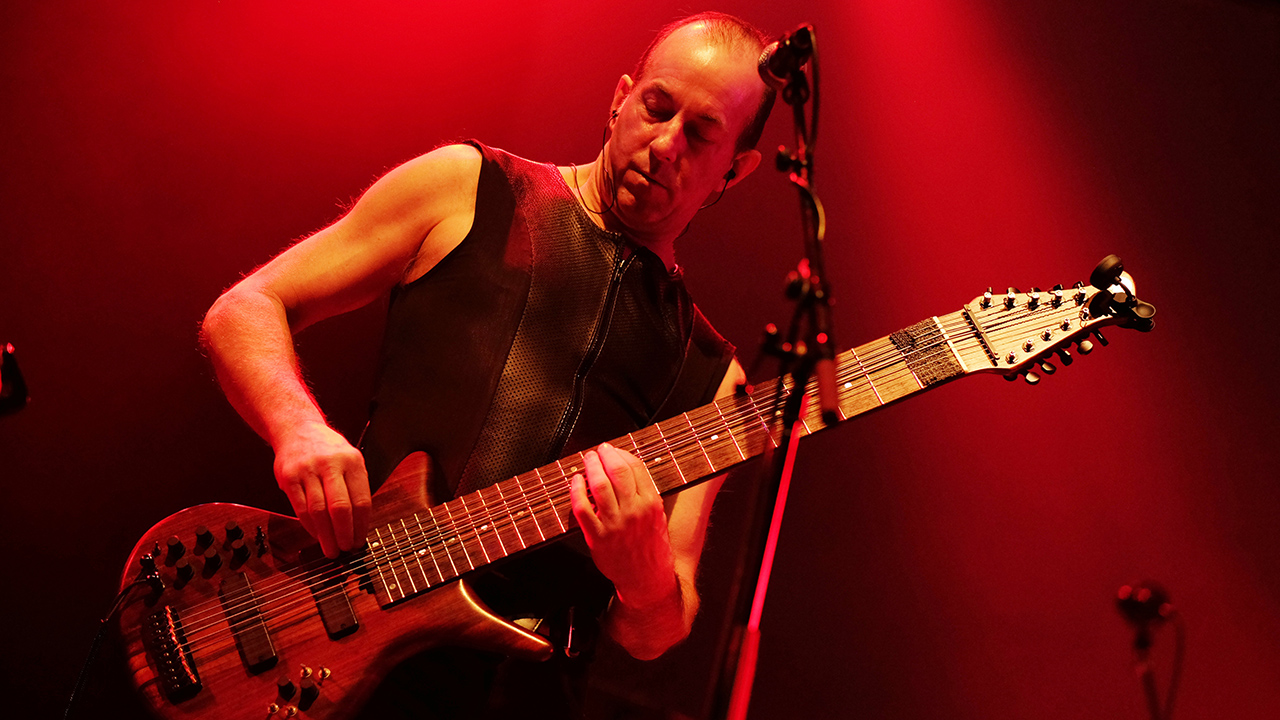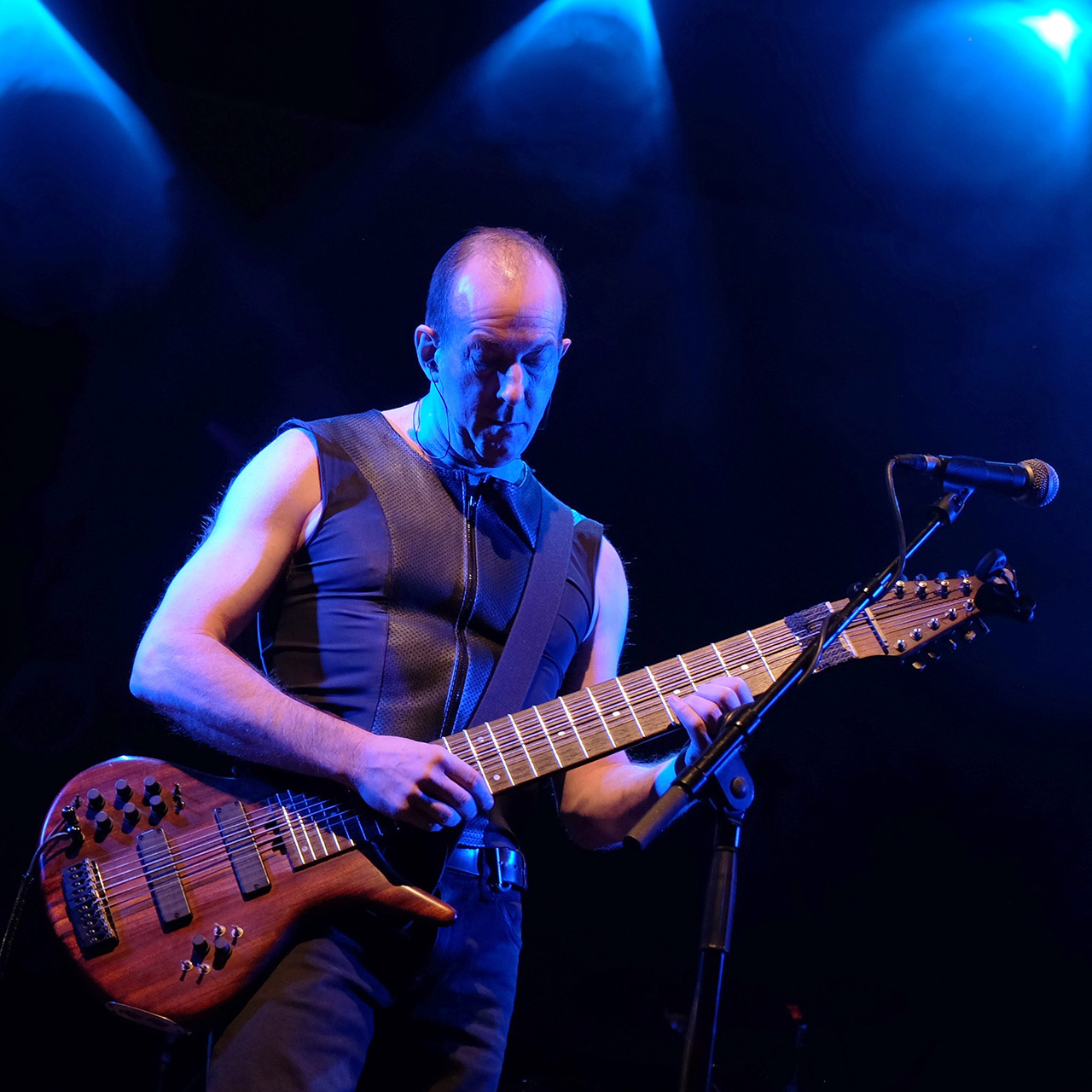“The process with Robert was so intense – I feel like I helped create almost a new genre with King Crimson with each piece of music we made”: Trey Gunn on what he learned from Robert Fripp – and how to tame the Warr Guitar
The 10-string instrument isn’t actually a guitar, says the former King Crimson member – and he doesn’t plan to ever stop exploring it in improv groups like Tu-Ner

Best known for brandishing a Warr Guitar as a member of King Crimson from 1993 to 2003, Trey Gunn has stretched the bounds of instrumentation beyond the confines of six strings.
It’s not that he’s bored by standard guitars – it’s more that his mindset and muse drive him to dive headfirst into the obtuse. “I don’t know when it was, but at some point, I realized how different the Warr Guitar was, and that got me thinking about how challenging it was going to be,” he says.
“Once my wrists and elbow pain started from holding it traditionally, I laid it horizontally across my lap; I had to think about it even more differently. It can be hard to explain, but for me, the Warr Guitar is like 10 different instruments next to each other – and sometimes just one string is enough to do plenty of things.”
That sort of thinking has Gunn at it again, this time alongside King Crimson alum Pat Mastelotto, who partnered with Gunn on Tu-Ner. As has long been the case, Tu-Ner is brimming with Warr Guitar, and off-the-beaten-path sounds that only a player like Gunn could come up with.
“I’m always thinking about the whole octave of a string or even two octaves of a string,” he explains. “With the Tu-Ner record – which I’d say was like 98 percent improvised – I’d take maybe a weird, synthesized sound, look at the range of the Warr Guitar, or maybe just two strings, stick with it, and improvise with those sounds.”
Of course, he’s no stranger to improvisation, having played alongside the king of the field, Robert Fripp. “We all have what I’d call musical language influences and with those come strategies and attitudes,” Gunn says. “And there’s no denying that Robert influenced me in all those ways.”
“King Crimson operates within a very specialized language, which evolved throughout the different incarnations of the band. I feel like I helped create almost a new genre with King Crimson with each piece of music we made.
Get The Pick Newsletter
All the latest guitar news, interviews, lessons, reviews, deals and more, direct to your inbox!
“The process with Robert was so intense, and if you’re not grabbing musical vocabulary off the shelf and assembling it for your purpose, you’re missing out.”
Your trademark has long been the Warr Guitar. How would you describe the instrument?
“The Warr Guitar is within the family of touch instruments, which are exclusively made for tapping, although you can do other things. My use of it grew out of me playing the Chapman Stick back in the ‘80s, which is also used for tapping and, like the Warr Guitar, has bass and guitar strings.”
What led to you favoring the Warr Guitar over the Chapman Stick?
“I met Mark Warr, who makes and builds these instruments for me, and I've been playing them ever since. It was after we finished King Crimson’s THRAK – I used it from there.”
Did you take to it immediately, as you did with the Stick?
“Yes. It has a group of bass and guitar strings, and I tune it like a cello, which opened a whole universe for me that wasn’t there with a regular guitar.
“The way I traditionally played it – which is funny since the instrument is only 30 years old – was having it hang down like a regular guitar. But it was destructive on my wrists and elbows.
“Another side story is that I wanted to have two instruments simultaneously with King Crimson – a fretted and fretless. So I put one of them on a stand, and that’s how I grew into playing the Warr Guitar horizontally, tapping it with the wrists and the arms held more like a piano style. And as far as I’m concerned, it’s infinitely better.”
Comfort aside, did your approach change when you began playing horizontally?
“The biggest thing is there are two angles to this instrument. Remember I don’t play it as a guitarist does – I don't think about positions. What’s weird about this instrument, and the general category of touch guitars, is that it looks like a guitar, has guitar strings, and you can play it like a guitar. But it's very different.
“If you play it in terms of positions and reach your fingers out from those positions, you’ll have crappy technique. Eventually, you’ll destroy your hands because the tapping won’t be efficient.
“I smoothly move my hands up and down the neck so I’m never stuck. I’m not thinking about the length of the string horizontally across the neck, or the group of strings; I'm always thinking longitudinally.”

And how has your mindset evolved since your days in King Crimson?
“The first thing is that I can hear much more. I don’t know if my playing is any better than when I was with King Crimson, but I can hear more overall. I’m more specific about what notes and rhythms are present. And I’m also more mindful about where the music wants to go – it tends to evolve a lot more.
“The hardest thing to do is listen to music I’ve been involved with in the past because I often feel like I wasn’t hearing things as I do now. I wish I could have heard music the way I do now back then; it would have been different.
“So that’s the biggest thing: I hear all the possibilities within a musical idea rather than being wrapped up in the sheer playing.”
Did Robert Fripp influence your approach to the Warr Guitar much?
“When you work with someone like Robert, they can’t help but rub off on you. We’d work on things sometimes where we’d have a little idea that we’d be kicking around for years and years and years.
“And when I say a little idea, it could be just two bars, a chord sequence, or a way of approaching chords. Then we’d take those building blocks and internalize them enough to speak with them.”
So some of the vocabulary from your King Crimson days lives on within your music today, then?
“I think so. The trick to making new vocabulary is you can’t just grab it and make sense of it right away, you know? You’ve got to digest it and be able to speak with it.
“Robert and I would explore these things for years before they would make it into a piece of music. And that approach is something that’s still part of me.
What’s amusing is, of late, I keep returning to the baritone ukulele. I love using it with my other instruments for some interesting pairings
“For example, in my solo work, I’m looking at the purpose of arpeggios and the variables I could have in an arpeggio that’s not normal, basically comes out of left field or has yet to be used. That kind of sonic exploration is something that Robert is great at and it definitely rubbed off on me.”
Outside of the Warr Guitar, has any kit caught your ear recently?
“I feel like I’m constantly evolving my gear, but when it comes down to it, I have four or five main sounds. I gravitate to those same sounds no matter what gear I use.
“It’s always very attack-based, punchy and bassy, which comes from the top side of my instrument and lends itself to very sustained sounds.
“But I have my harsh lead sound – with that, I live the kind of envelope filter type of thing, where there’s less attack. And that’s interesting because it's the opposite of the tapping approach. The point is, no matter the gear, I return to those sounds.
“But what’s amusing is, of late, I keep returning to the baritone ukulele. I love using it with my other instruments for some interesting pairings.”
Are you ever inspired to pick up a traditional guitar?
“Only if there’s something special about it; and if I do, I still use strange tunings that are just a bit twisted! But I am interested in certain pickups I could add to my instrument, where I’d have infinite sustain and some multi-phonic options.
“I know there are guitars out there that have that; I’d be curious about those. But with the Warr Guitar, there’s so much to explore, and I still have a lot to master, so I try not to get distracted.”
One might say you already are a master of the Warr Guitar. What advice would you give to a new player just picking it up?
“There are some core technical things that tapping players need to learn that, generally, guitar tappers don’t understand. Don’t get me wrong – there are some great guitar tappers, but there are aspects of the technique that I’ve figured out that you can learn quickly. Track me down and I’ll give a quick lesson to get you started.
There are some core technical things that tapping players need to learn that, generally, guitar tappers don’t understand
“To summarize, you’ve got to be relaxed, which is a contradiction of the instrument because you’d think with tapping, you’d have to be so focused on where your fingers are.
“But really, the most important thing is the release of the string rather than where you put your finger. You won’t get good sound unless you have good release. So, be relaxed, practice, and learn when to release the note.”
- Tu-Ner’s debut album T1 - Contact Information is out now.
Andrew Daly is an iced-coffee-addicted, oddball Telecaster-playing, alfredo pasta-loving journalist from Long Island, NY, who, in addition to being a contributing writer for Guitar World, scribes for Bass Player, Guitar Player, Guitarist, and MusicRadar. Andrew has interviewed favorites like Ace Frehley, Johnny Marr, Vito Bratta, Bruce Kulick, Joe Perry, Brad Whitford, Tom Morello, Rich Robinson, and Paul Stanley, while his all-time favorite (rhythm player), Keith Richards, continues to elude him.
“It holds its own purely as a playable guitar. It’s really cool for the traveling musician – you can bring it on a flight and it fits beneath the seat”: Why Steve Stevens put his name to a foldable guitar
“Finely tuned instruments with effortless playability and one of the best vibratos there is”: PRS Standard 24 Satin and S2 Standard 24 Satin review










